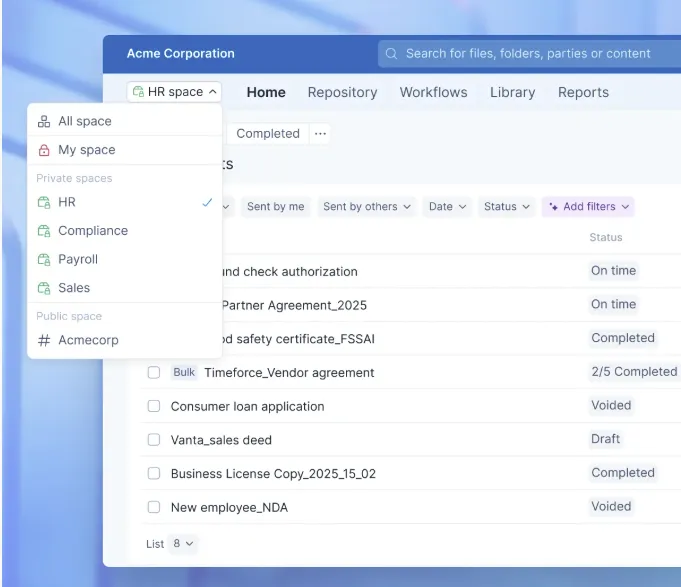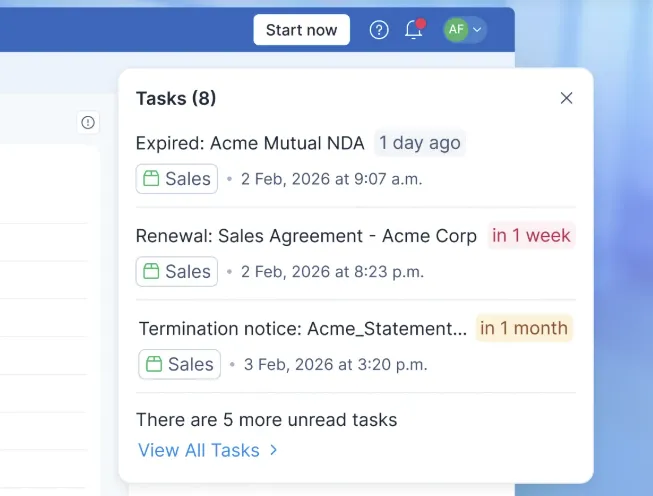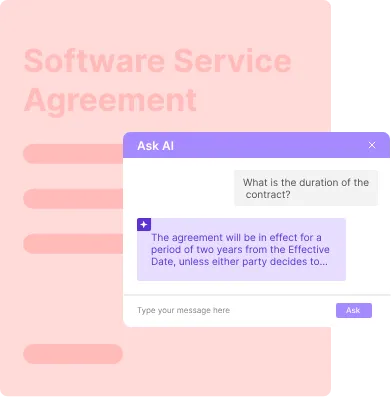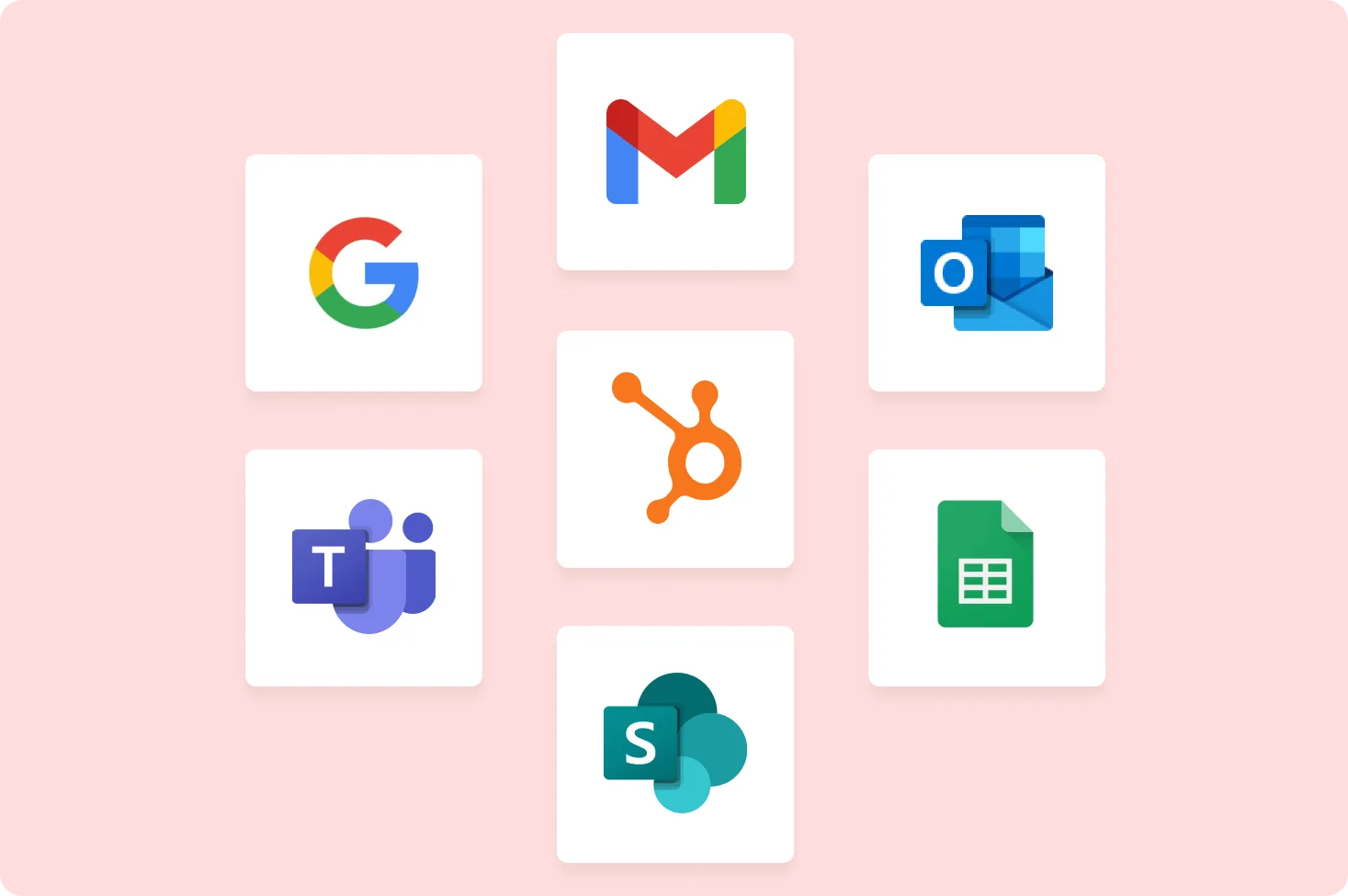Key Takeaways
- Contract intelligence changes traditional contract management by using AI and machine learning to extract insights, automate reviews, and identify risks and opportunities hidden within contracts.
- The technology turns contracts into strategic assets to help teams forecast revenue, manage obligations, and uncover growth opportunities instead of treating agreements as static documents.
- Successful contract intelligence implementation requires clear goals, integration with existing systems, and strong stakeholder alignment to ensure adoption across legal, finance, and procurement teams.
- With Signeasy, implementing contract intelligence is simple with AI-driven data extraction and smart reminders.
Contract intelligence uses smart technologies like AI and machine learning to help businesses understand, manage, and get valuable insights from their contracts, making the whole process faster and easier.
Business operations rely on contracts as they govern relationships, obligations, and revenue across industries. Historically, managing these agreements relied on manual processes, which were often time-consuming, error-prone, and limited in scalability.
Over time, technology has transformed traditional contract management through digital storage and workflow automation. However, as businesses face increasing complexities in their contracts, the need for more advanced solutions has led to the rise of contract intelligence.
In this blog, we’ll explore:
- The essentials of contract intelligence — its meaning, key features, and main benefits
- Common challenges and best practices for smooth implementation
- How contract intelligence differs from traditional contract management
- Real-world use cases to help you decide if it’s the right investment for your business
What is contract intelligence?
Contract intelligence refers to the use of advanced technologies, such as artificial intelligence (AI) and machine learning (ML), to analyze, manage, and extract actionable insights from contracts.
Traditional contract management focuses mainly on storing and organizing documents. Contract intelligence takes it a step further — interpreting the data within contracts to uncover insights, automate routine processes, and provide a deeper understanding of terms, obligations, and potential risks.
How contract intelligence helps different teams
Unclear roles, manual data extraction, and difficulty tracking key details often lead to contract rollovers, missed obligations, or even compliance breaches.
Contract intelligence resolves these challenges and helps teams work more efficiently across the organization:
- Procurement teams: Automatically track contract deadlines and prevent missed renewals. They can also identify cost-saving opportunities — for instance, by receiving alerts when supplier agreements approach expiry. Additionally, teams can sort contracts by vendors to assess performance, review payment terms, and make informed renewal decisions.
- Legal teams: Detect potential risks and compliance issues through AI-based clause review. This allows them to focus on non-standard terms instead of spending hours scanning entire documents. They can also sort contracts based on whether specific clauses are included, making it easier to identify gaps or inconsistencies.
- Business teams: Access insights on contract value and timelines to plan strategically. They can also spot high-performing contracts that contribute the most to quarterly targets.
- Finance teams: Improve forecasting accuracy and revenue recognition by connecting contract data with billing systems. They can also flag recurring payment terms or pending milestone invoices for timely action.
- Sales teams: Speed up deal cycles with automated contract creation and smoother approval flows. Pre-approved templates generated directly from Salesforce reduce turnaround time for every deal.
- HR teams: Simplify employee agreement management and ensure policy compliance. With centralized dashboards, HR can instantly track contract renewals, onboarding forms, and consultant agreements.
- IT teams: Manage vendor and software license contracts more efficiently. Automatic reminders and analytics help them maintain compliance and control costs across multiple tools and vendors.
For these teams to collaborate effectively and act on real-time insights, they need a unified workspace where every contract stays connected and accessible.
Signeasy’s Intelligent Contract Repository makes this possible by bringing all agreements and related data into one organized system.
Key capabilities of Signeasy’s Intelligent Contract Repository
A centralized repository converts scattered documents into a single, intelligence-driven source of truth. It gives every team — from legal to finance — the ability to search, organize, and act on contract data with precision and speed.
Below are the core capabilities that make this possible:
1. Smart search and tailored views
AI-powered search helps users locate contracts, clauses, or key data points instantly — even within complex documents. Teams can also create tailored views based on contract type, renewal date, owner, or department to focus on what matters most.

2. Shared workspaces for seamless collaboration
Procurement, legal, finance, and sales teams can work within shared spaces that define clear roles and permissions. Everyone accesses the same version of each agreement, reducing duplication and ensuring consistent, organization-wide visibility.

3. Automated alerts and milestone tracking
Built-in notifications keep stakeholders informed about renewals, deliverables, and compliance checkpoints. Timely reminders help teams stay proactive, maintaining accountability and control across the contract lifecycle.

4. Intelligent organization and metadata enrichment
Each uploaded document is automatically indexed and tagged with key attributes such as contract type, value, and status. This structured metadata enhances discoverability, accelerates reporting, and supports data-driven decision-making at scale.
How does contract intelligence work?
Contract intelligence transforms static documents into structured, searchable insights. Here’s a step-by-step look at how it processes, analyses, and delivers value across the contract lifecycle.
Step 1. Ingest and normalize
Contracts arrive in different formats — PDF, Word, or scanned images. The system uses OCR and AI parsing to convert them into clean, machine-readable text.
Step 2. Classify and index core metadata
It identifies the contract type (NDA, MSA, SOW, etc.) and extracts key metadata such as parties, dates, amounts, and jurisdictions to establish a structured foundation.
Step 3. Extract clauses and terms
Natural language processing (NLP) models detect important elements like renewal windows, payment terms, termination rights, SLAs, and obligations — along with their clause locations.
Step 4. Detect deviations and risks
The system compares extracted terms against approved templates or policy standards to flag non-standard language, missing protections, or regulatory triggers.
Step 5. Review and enrich
Users can validate or refine extracted details in a side-by-side interface. Each record is enriched with ownership, departmental tags, and relevant business attributes.
Step 6. Store, search, and share
Validated data and documents are stored in a centralized repository. Teams can quickly locate information using AI-driven search, filters, and saved views for audits or renewals.
Step 7. Notify and route work
Renewal dates, deliverables, and obligations automatically generate alerts and tasks. Contract approvals and revisions move through predefined workflows for timely execution.
Step 8. Analyze and improve
Dashboards reveal trends such as frequently negotiated clauses, contract cycle times, and risk exposure by vendors. Insights from these patterns help refine future templates and negotiation strategies.
Contract management vs. contract intelligence
The difference between contract management and contract intelligence lies in their focus, functionality, and the level of technology they employ. While both deal with contracts, they serve distinct purposes and cater to different organizational needs.
Contract management refers to the process of organizing, storing, and retrieving contracts to ensure they are accessible and secure. It focuses on the administrative aspects of the contract lifecycle, such as creating templates, filing agreements, and tracking renewal dates.
Traditional contract management systems typically rely on manual processes and are limited to being a centralized repository for contracts. Their primary goal is to ensure compliance and efficient handling of contract-related documentation.
On the other hand, contract intelligence takes contract management to the next level by leveraging AI in contracts to extract, analyze, and generate actionable insights from contract data.
It focuses on turning contracts into dynamic assets that provide strategic value. By automating data extraction and risk analysis, contract intelligence enables businesses to proactively identify opportunities, track obligations, and make informed decisions in real time.
Key differences between contract management and contract intelligence
Benefits of an effective contract intelligence tool
An effective contract intelligence tool offers transformative benefits, enabling organizations to unlock the full potential of their contracts.
“Where I see AI really making a substantive impact is in contract extraction and contract review. While on the extraction side, it can enable the speed of business, with review automation, AI can enable speed in the law department.”
—Lucy Bassli, InnoLaw Group, PLLC
Using an effective contract intelligence tool has the following benefits:
1. Enhanced risk management
Contract intelligence tools can identify and flag risky or non-standard clauses that could expose organizations to legal, financial, or compliance issues. They can automatically detect deviations from preferred templates or regulatory standards; assign risk levels to contracts to enable prioritization of reviews; and flag missing or non-compliant clauses to reduce legal exposure.
2. Increased efficiency through automation
By automating repetitive and time-consuming tasks, contract intelligence tools like Signeasy AI significantly reduce manual effort. They can help to automatically extract metadata, terms, and clauses from contracts; streamlines contract reviews, approvals, and negotiations; and enable fast, accurate searches for specific clauses or terms across large contract repositories.
3. Improved obligation and milestone tracking
These tools ensure organizations stay on top of their commitments by automating the tracking of key dates and deliverables. They can notify stakeholders of upcoming renewal dates, payment deadlines, and milestones; track the fulfillment of contractual obligations to avoid penalties or disputes; and prevent unwanted contract renewals or lapses.
4. Actionable insights and analytics
Contract intelligence tools provide advanced analytics that enable organizations to make data-driven decisions. They can identify patterns in negotiations, vendor performance, or contract terms. They can use historical data to predict outcomes, such as revenue opportunities or potential risks. These tools can also provide real-time insights tailored to specific business needs.
5. Revenue optimization
By improving visibility into key terms and opportunities, contract intelligence tools help organizations maximize their revenue potential. They can highlight opportunities to renew or expand contracts with existing clients; ensure compliance with pricing and billing terms to capture all revenue; and speed up the process by ensuring accurate and timely processing of contracts.
6. Cost savings
Automating processes and minimizing risks lead to significant cost reductions. A contract intelligence tool identifies and mitigates risks early, avoiding expensive legal disputes. It cuts down on time and resources spent on manual tasks. It also identifies underperforming vendors or unfavorable contract terms.
7. Faster time-to-value
Effective tools accelerate the time it takes to derive value from contracts. Modern tools often offer intuitive interfaces and seamless integrations. They can instantly retrieve key information to make timely decisions. Timely automated insights also help speed up negotiations and approvals.
Challenges in implementing contract intelligence tools
Implementing contract intelligence tools comes with a range of challenges, many of which stem from technical, organizational, and operational complexities.
1. Resistance to change
Employees accustomed to traditional contract management processes may hesitate to adopt new technology, fearing disruptions to their workflows or an increased workload. Organizations with less tech-savvy workforces may encounter cultural barriers, and securing leadership buy-in requires demonstrating the tool's value and return on investment early in the process.
2. Lack of training and skills
Teams may require specialized knowledge to operate the tool effectively, especially when it involves understanding AI-driven features like machine learning-based data extraction. Employees unfamiliar with these technologies may face a steep learning curve, and ongoing support is often necessary as the tool evolves or organizational needs change.
3. Privacy and security concerns
Ensuring data protection, meeting industry-specific regulations, and implementing robust security measures like encryption and role-based access controls are essential but require careful planning. Cybersecurity risks further complicate implementation, especially when integrating with external systems.
4. AI-models
Contract intelligence tools often rely on AI models that require time and training to deliver accurate results. Early inaccuracies in data extraction or categorization can necessitate manual corrections, and regular updates to the AI models are needed to maintain effectiveness.
5. Selecting the right vendor and tool
With numerous options available, it can be difficult to identify a solution that aligns with an organization’s specific needs. Some tools may lack critical features, such as support for multi-jurisdictional contracts or industry-specific compliance requirements. Additionally, organizations must ensure that the chosen tool can scale with increasing contract volumes and complexity.
Best practices of contract intelligence
Best practices for implementing and making the most of contract intelligence cover a range of activities, from preparation and implementation to long-term optimization. These include the following:
- Define clear objectives: Set specific goals for what you want to achieve with contract intelligence.
- Audit existing contracts: Clean up and organize your contract repository for accurate data extraction.
- Select the right tool: Choose a solution with AI-driven capabilities, scalability, and seamless integrations.
- Standardize templates: Use consistent contract formats and clause language for better accuracy.
- Integrate with existing systems: Ensure the tool works seamlessly with CRM, ERP, and other platforms.
- Automate routine tasks: Use automation for obligations tracking, renewal alerts, data extraction, and other routine tasks.
- Leverage analytics: Use dashboards and insights to monitor performance and identify trends.
- Ensure data security: Implement strong governance, encryption, and role-based access controls.
- Train teams: Provide comprehensive training and ongoing support for tool adoption.
- Align departments: Encourage collaboration between legal, procurement, sales, and other teams.
- Monitor and optimize: Regularly review metrics, refine workflows, and retrain AI models.
- Use data proactively: Identify risks, forecast trends, and uncover opportunities for strategic decision-making.
Implementing contract intelligence
The first step to implementing contract intelligence is identifying high-value use cases. Do you need to automatically extract data like payment terms or renewal dates from high-value contracts or set up workflows that trigger reminders for approaching deadlines?
Once you narrow down the use cases, follow these steps:
1. Engage stakeholders early
Contract Intelligence impacts teams across finance, legal, and procurement, so bring them in from the start. Focus on real benefits, like helping finance forecast expenses or helping procurement track vendor contracts easily.
2. Integrate with existing tools
Connect contract intelligence to systems your teams already use, such as CRMs or ERPs like Hubspot CRM, Google, or Microsoft. These integrations let data flow easily so sales can check contract terms instantly, and finance teams have full budget visibility.
3. Automate repetitive workflows
Free your team from manual tasks by automating approvals, renewals, and compliance checks. You can use Signeasy’s standardized templates to reduce errors, predefine roles and fields for efficiency, or simply add the signer's email to send the contract. It also sends auto-reminders on days 1 and 7 to keep signers and contracts on schedule.
4. Choose a smart eSignature tool
Making contract management intelligent gets simpler with a tool with AI-powered capabilities. For instance, Signeasy sets alerts for crucial contract milestones, answers questions, pulls out quick summaries, and identifies and extracts key terms and contract clauses.
Lastly, show finance how to forecast with metadata and legal how to manage risk as relevant training will build confidence and make adoption quick.
Evaluating contract intelligence tools
Evaluating contract intelligence tools requires a thorough assessment of their features, the vendors offering them, and their adaptability to organizational needs.
Here is a detailed guide that can help you evaluate the right contract intelligence tool for your business.
1. Key features to look for in software
When evaluating contract intelligence software, organizations should prioritize features that meet their specific business requirements. Key capabilities to assess include:
- AI-powered data extraction features that accurately extract terms, clauses, and metadata from contracts, regardless of format
- Obligation tracking feature to identify and monitor key contractual obligations, deadlines, and renewal dates
- Advanced search and analytics for contextual search and dashboards for actionable insights into contract performance and risks
- Workflow automation to automate processes like approvals, renewals, and compliance tracking
- Integration capabilities to ensure compatibility with existing systems such as CRM, ERP, or procurement platforms for seamless data sharing
- Compliance management features that assist with regulatory compliance by identifying risks and gaps in contract terms
- Security features like data encryption, role-based access, and audit trails to safeguard sensitive information
2. Vendor selection criteria
Choosing the right vendor is critical to the successful implementation of a contract intelligence tool. Organizations should evaluate vendors based on several key factors.
First, prioritize vendors with industry expertise, as those familiar with your sector are better equipped to address specific challenges and compliance requirements.
Next, assess the availability and quality of customer support, including training, onboarding, and troubleshooting assistance, to ensure smooth adoption.
It’s also essential to research the vendor’s reputation by reviewing case studies, client testimonials, and performance history to gauge reliability.
Opt for vendors with a clear innovation roadmap that demonstrates their commitment to future updates and features aligned with technological advancements.
Ensure cost transparency by requesting a detailed breakdown of expenses, including licensing, implementation, training, and ongoing support.
Finally, ask for a demonstration or trial to evaluate the software’s user experience and functionality before making a commitment.
3. Scalability and customization options
Key considerations to evaluate the right contract intelligence tool include:
- Scalability: Verify that the tool can handle increasing contract volumes, users, and complexity as your business grows.
- Customization: Assess the tool’s ability to tailor workflows, templates, and dashboards to align with your organization’s unique requirements.
- Multi-jurisdictional support: For global businesses, ensure the tool accommodates different legal frameworks and languages.
- Integration flexibility: Confirm that the tool can integrate with future systems or adapt to changing IT infrastructure.
- AI training: Evaluate whether the tool’s AI capabilities can be trained on specific contract types, clauses, and organizational standards over time.
“Do not jump into AI or CLM technology unless you can answer at least some basic questions like how contracting is run today in your company, who’s approving contracts, which types, and why, what role you want legal to play in the future, what role you want the different business units to play in the future, and how many contract types you think you can automate with the new technology. As part of your readiness, another question you should ask before you buy technology is what your top pain point is that you think the technology will solve.”
—Lucy Bassli, InnoLaw Group, PLLC
Is contract intelligence software worth it?
Investing in contract intelligence software can be a game changer for organizations aiming to streamline operations, reduce risk, and maximize value. However, assessing whether it is worth it requires a nuanced understanding of both the benefits and the contexts in which such tools deliver optimal results.
1. Cost-benefit analysis
From a cost-benefit perspective, the initial investment in contract intelligence software, which includes subscription fees, training, and implementation, may seem significant. Yet, the long-term gains often outweigh these upfront costs.
For example, these tools enable businesses to save time on manual tasks, reduce costly errors, and improve compliance with contractual obligations. As organizations scale, the software grows with them, handling larger contract volumes and supporting more complex agreements without a proportional increase in administrative costs.
2. Return on investment (ROI)
Research and case studies underscore the ROI associated with contract intelligence.
According to a Deloitte study, organizations that adopt contract intelligence tools see an average ROI of over 150%.
The study highlights that advanced contract management solutions can accelerate deal cycles by 20% and reduce the risk of revenue leakage by as much as 9%. Such improvements translate into measurable financial and operational benefits, especially for enterprises managing thousands of contracts annually.
3. When contract intelligence isn’t necessary
Sometimes, less is more. If your contracts don’t involve much complexity or risk, basic systems can meet your needs without the extra bells and whistles. Here are cases when you don’t need a contract intelligence tool.
- Few contracts to manage – If a business handles only a small number of contracts.
- Simple, standard agreements – When contracts are straightforward and don’t require deep analysis.
- Limited budget – For companies that can’t justify the cost of advanced tools.
- No complex processes – If contracts don’t involve risks, negotiations, or compliance issues.
- Existing tools are enough – When current systems meet all contract needs.
- Short-term agreements – For businesses dealing mostly with temporary or informal contracts.
- Early-stage businesses – Startups with simpler processes and priorities elsewhere.
Ultimately, whether contract intelligence is worth it depends on your organization’s size, complexity, and growth trajectory. For businesses managing a high volume of intricate contracts or looking to scale operations efficiently, the investment often proves invaluable.
How you can implement contract intelligence with Signeasy
Turning contract intelligence into an everyday advantage is simpler than you think. With Signeasy, you can move from scattered documents to smart, connected insights in just five steps.
Step 1. Centralize your contracts in an intelligent repository
Bring every agreement — past and present — into one secure location. Signeasy’s Intelligent Contract Repository lets you store, organize, and access all your contracts from a single dashboard.
Step 2. Use AI to extract key terms and generate instant summaries
Let Signeasy AI handle the heavy lifting. It automatically identifies critical terms such as payment conditions, renewal dates, and obligations, then generates concise summaries for quick review.
Step 3. Ask questions or search directly within your contracts
Need to know “What’s the termination clause?” Just ask. You can query any contract or use smart search to pinpoint relevant clauses instantly, turning static text into searchable, actionable data.

Step 4. Set up alerts and reminders for critical milestones
Stay on top of renewals, obligations, and compliance checkpoints. Signeasy automatically sends reminders and alerts, helping your team act before deadlines — not after.
Step 5. Automate approvals and manage roles effortlessly
Signeasy comes ready with built-in integrations for Google Workspace, Microsoft 365, and popular CRMs. You can automate approval flows, assign roles, and track every signature and contract status in real time, all within one connected system.

Conclusion
Contract intelligence represents more than just a technological advancement. It signifies a shift in how organizations approach the critical task of managing contracts.
The takeaway is clear: the value of contract intelligence lies not just in what it can do today but in its potential to grow alongside your organization. Investing in these tools means investing in a future where contracts become assets, not liabilities.
For organizations ready to embrace this change, the journey begins with asking the right questions, choosing the right solutions, and committing to continuous innovation in how they approach contract management.
Signeasy can be your trusted partner on this journey. With its intuitive platform and AI-powered features, Signeasy helps you simplify contract management, extract actionable insights, and stay ahead of deadlines.











